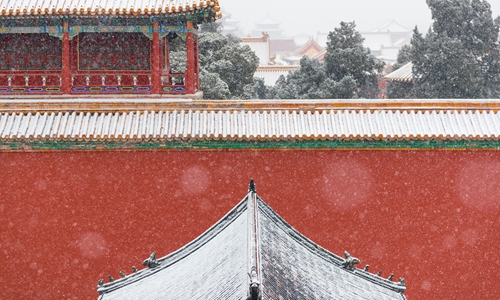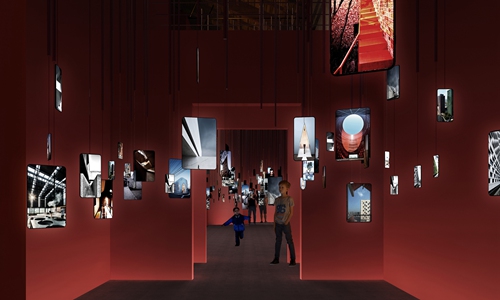China's 'Yuan-er' to debut at Venice architecture biennale

Snow in the Forbidden City Photo: Courtesy of The Palace Museum
Pavilion of PR China will make an inquiry on the traditional Chinese cohabitation typology Yuan-er, and show projects that give contemporary interpretations to this typology at the 17th International Architecture Exhibition - La Biennale di Venezia from August 29 to November 29. Modern display technologies will be used to help present this inquiry, from the old to the new, according to China's curating team.
During the biennale, China, along with 62 other countries will showcase their creative architecture work at the Biennale, the most revered architecture event around the world, at the Giardini, the Arsenale, and Forte Marghera, according to the event's official website.
The Biennale Architettura 2020 theme, defined by curator Hashim Sarkis, "How will we live together", asks how architecture may contribute to equality, connectivity and unity. It is a statement of contemporary world architecture's refocusing on people.
The topic of China Pavilion, Yuan-er, is exactly an extension of the Biennale theme. Over 150 architects practicing in China will contribute to the project, which is the largest number yet for China pavilion. These contributors will cover a broad spectrum of approaches and localities, from the avant-garde to the historians, from individualists to urbanists, from those who renovates heritages to those who have just completed the giant rapid-assembled hospital in Wuhan, Central China's Hubei Province.

Together We Learn_Inspiration & Interventions Photo: Courtesy of Atelier Team Minus
Curation description
"The topic reflects the turning page of contemporary architecture, both to Chinese and the world. Compared to the obsession with forms at the end of last century, architects today are reaching a world-wide consensus that architecture has to address the life of normal people, if it is to remain a positive force in our civilization," Zhang Li, Vice Dean of Tsinghua School of Architecture and Vice Principal of Architectural Design and Research Institute of Tsinghua University, curator of Pavilion of PR China, told the Global Times on Sunday.
The Chinese word Yuan-er means a multi-family courtyard, referring to both its physicality and the people inhabiting it. It has been the basic molecule of all traditional urban and social fabrics in China, with cases ranging from the mega, like the Forbidden City, to the micro, like hutong. Not only has it been the bearer of ideas of the past, it is also continuing to inspire architects and artists looking for hints of the future.
Exhibition exploration
According to Zhang, China Pavilion makes an inquiry on Yuan-er. "Why was it able, and is still able to bring people of such diversity closer to each other? What are the space-body relations that generate cohesive urban communities extending from one yuan-er to another? How would wisdoms of past yuan-ers benefit architecture of our time for people to live together, online as well as offline," he said.
China Pavilion has 5 sections. In Section 1, Together we learn (Part I), various architects practicing in China are invited to give individual stories of inspirations and interventions related to yuan-er, through videos played on tablets and phones. In Section 2, Together we learn (Part II), 6 Chinese architects plus 6 historians dissect classic cases and give radical contemporary interpretations through hologram projections. In Section 3, Together we design, visitors are invited to design their own yuan-ers, using the engine designed by an AI artist featuring vocabularies of 6 young Chinese architects. In Section 4, Together we feel, an artist's sound installation takes the visitors to a journey of senses in yuan-er. In Section 5, Together we heal, the parlour in the real yuan-er (the garden) outside China pavilion shares stories of life together (offline and online) through the coronavirus epidemic.
Historical inspiration
Yuan-er has been around for more than 2,000 years in China. This year marks the 6th centennial for the Forbidden City, which is considered as the most sophisticated and distinguished example of yuan-er. Borrowing its wisdom will certainly shed some light on the future. China Pavilion's curation team have invited experts from the Palace Museum to advice on the research, to help identify the underlying cultural genes.
Zhang said the organizers of La Biennale di Venezia were excited after learning that Yuan-er would showcase contemporary interpretations inspired by a widely known cultural heritage. "They know very well that the Forbidden City is an imperial palace, but have never looked at it as a highly complex yuan-er," he said.
Such investigations and reinventions will always be beneficial to architecture culture, particularly so for contemporary China. "China is already one of the most important architectural stages of the world. You see a vast variety of approaches, and a huge amount of experiments. The age of extensive growth and quantity has passed, the age of quality is arriving," Zhang said.
Zhang remains optimistic on the future of Chinese architecture. He is pleased to see the younger generation having a better understanding of both humanity and nature, and being more deeply engaged in the world debate today.
"The best time of Chinese architecture is yet to come," Zhang said.